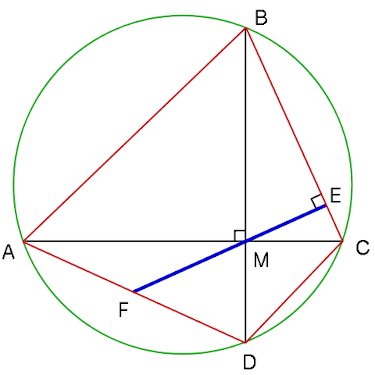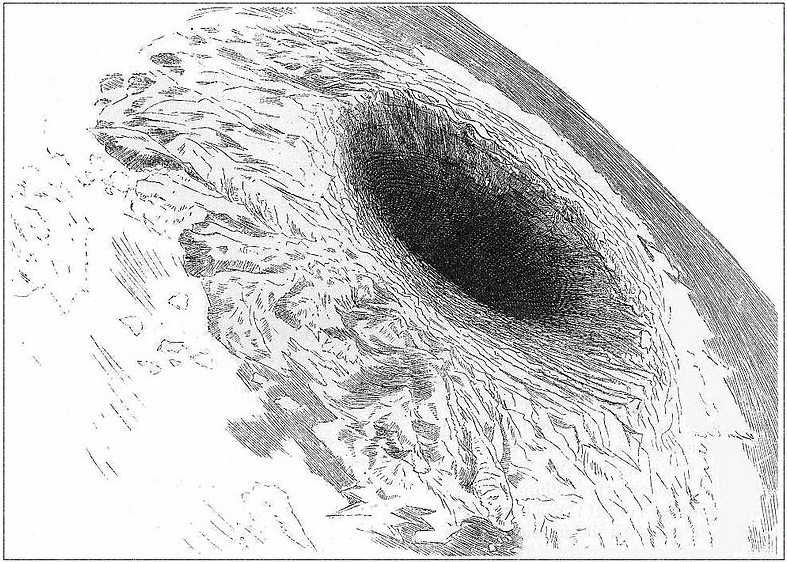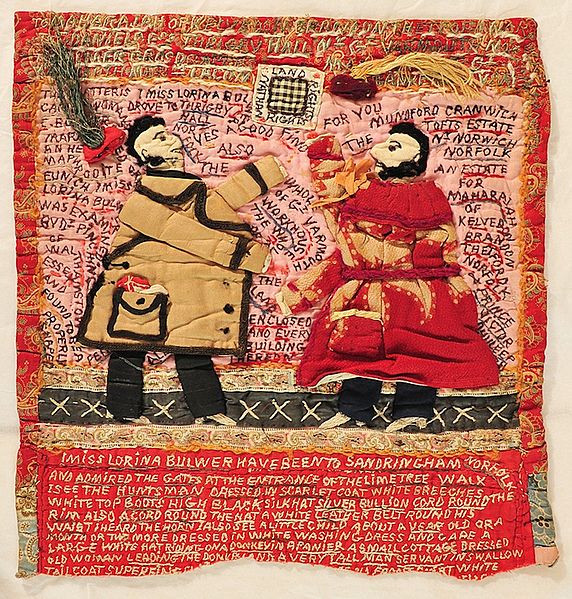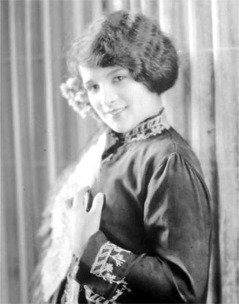
If a quadrilateral’s vertices lie on a common circle and if its diagonals are perpendicular, then a perpendicular to one side that passes through the intersection of the diagonals will bisect the opposite side.

If a quadrilateral’s vertices lie on a common circle and if its diagonals are perpendicular, then a perpendicular to one side that passes through the intersection of the diagonals will bisect the opposite side.

In 1818, Army veteran John Cleves Symmes Jr. declared that the earth was hollow and proposed to lead an expedition to its interior. He promoted the theory in lectures and even won support on Capitol Hill. In this week’s episode of the Futility Closet podcast we’ll describe Symmes’ strange project and its surprising consequences.
We’ll also revisit age fraud in sports and puzzle over a curious customer.

When 55-year-old Lorina Bulwer was placed in the Great Yarmouth Workhouse in 1893, she embroidered protests into long pieces of patchwork fabric, ranting in unpunctuated capitals:
THE CHATTER IS I MISS LORINA BULWER CAMBS WOMAN DROVE TO THRIGBY HALL NORFOLK E. BULWER MARRIED AN HEMAPHRODITE EUNICH I MISS LORINA BULWER WAS EXAMINED BY DR PINCHING OF WALTHAMSTOW ESSEX AND FOUND TO BE A PROPERLY SHAPED WOMAN …
Much of the invective is directed against E Bulwer and Queen Victoria, apparently trying to connect Bulwer’s family to prominent families of the time and possibly referring to sexual abuse in a scandal of 1859. But her reasons for making the samplers aren’t entirely understood.
Ruth Burwood, adult learning officer for Norwich Museums, told the Eastern Daily Press, “In very basic terms there isn’t anything like them in the world, they’re just absolutely extraordinary; the fact she was a woman in a lunatic ward in Great Yarmouth workhouse and was somehow able to produce these embroideries. Workhouse inmates did do sewing but this is almost like she’s been allowed to do this as therapy.”
In a 2005 experiment, psychologist Petter Johansson and his colleagues presented each subject with two photographs of women’s faces and asked which they found more attractive. In each case the experimenter then presented the “chosen” photograph and asked the subject to explain their choice. But in fact, using sleight of hand, the experimenter had exchanged the photos and was presenting the one that the subject hadn’t picked.
Only 13 percent of the subjects noticed the change; the rest went on to confabulate an explanation justifying a choice they hadn’t made. And yet, in post-test interviews, 84 percent of the subjects said that they would have detected such a switch if one had been made.
A subsequent experiment involving supermarket taste tests of jam showed the same effect: Subjects indicated an initial preference and then (after the samples had been surreptitiously swapped) failed to recognize that they were now tasting the rejected variety and went on to justify that choice.
Johansson and his colleagues called this choice blindness. “We do not doubt that humans can form very specific and detailed prior intentions,” they wrote, “but as the phenomenon of choice blindness demonstrates, this is not something that should be taken for granted in everyday decision tasks.”
(Petter Johansson et al., “Failure to Detect Mismatches Between Intention and Outcome in a Simple Decision Task,” Science 310:5745 [Oct. 7, 2005], 116-119.) (Thanks, Colin.)
The more similar two options are, the more difficult it is to decide between them, and the less consequential the decision becomes. A rational decider might find herself spending the most time on the least important decisions.
Philosopher Edward Fredkin writes, “The more equally attractive two alternatives seem, the harder it can be to choose between them — no matter that, to the same degree, the choice can only matter less.”
To avoid this, the decider might resolve to apportion her decision-making time by the importance of the decision. But this requires assessing the importance of every decision, which requires evaluating the means she’s using to make those assessments, and so on.
Psychologist Gary Klein writes, “[[I]f I want to optimize, I must also determine the effort it will take me to optimize; however, the subtask of determining this effort will itself take effort, and so forth into the tangle that self-referential activities create.”

In her 1929 autobiography Cradle of the Deep, silent film star Joan Lowell revealed a dramatic childhood aboard her father’s trading vessel: She’d seen a man eaten by sharks, performed an amputation, and, when the ship caught fire and sank, swum three miles to the Australian coast with “drenched kittens” clinging to her shoulders:
I was conscious of only the pain caused by the salt water on my bleeding cuts and scratches. Each stroke I took was like a knife cut, and I couldn’t shake the drowning kittens off. Perhaps to those cats I owe my life, for the pain made me so mad I fought on and on, toward the lightship which seemed to go farther away instead of closer.
When it was published, sailing writer Lincoln Colcord identified 50 inaccuracies and called her to account. It turned out she’d made the whole thing up: Her father had worked on the boat for about a year, and she’d made one trip on it. Simon & Schuster reclassified the book as fiction and released a statement saying it had been “published in good faith, not as a literal autobiography but as a teeming yarn, fundamentally a true narrative but inevitably … embroidered with some romanticized threads.”
“It is more from carelessness about truth than from intentional lying that there is so much falsehood in the world.” — Samuel Johnson
From the minutes of the city council of Deer Park, Texas, Aug. 31, 1965:
After some discussion, it was moved by Councilman Black and seconded by Councilman Young that we publish our intentions of annexation of the Planet Venus as required by law. The motion passed 7 to 0.
In July, when the Oklahoma Science and Arts Foundation had sought funds to pay for a scale model of the moon, the Oklahoma City council had annexed all 9 billion acres of Earth’s satellite and Mayor George Shirk had turned them over to the foundation.
Inspired, Lee Bishop, president of the Deer Park Chamber of Commerce, had convinced his local council to annex Venus so that they could sell lots as a fundraiser. The scheme helped the city produce a promotional film; Bishop said, “People have heard of Deer Park who probably never would have. The publicity, even though it was in jest, helped.”
When the U.S.S.R. sent a probe to Venus in 1967 without asking Deer Park’s permission, Bishop considered lodging a protest with the Soviet embassy. He decided against it to preserve international relations.
(From Virgiliu Pop, Who Owns the Moon?: Extraterrestrial Aspects of Land and Mineral Resources Ownership, 2008.)
In 2002, Melbourne friends Hoss Siegel and Ross Koger were battling with pool noodles and imagined a war fought in the same style. Months later they witnessed two kids beating each other up with cardboard boxes, and they married the two ideas.
The result is Box Wars, an annual free-for-all among combatants bearing weapons and armor made of cardboard. The pastime is now international, with extensions in Japan, the United States, Scotland, the Netherlands, Russia, and Canada.
“The suits,” says Koger, “have gotten more elaborate, as have the crowds, and it’s funny that something which spawned from a stupid idea at a party has become so big.”

This rare condition, also known as “spun-glass hair” and cheveux incoiffables, normally arises between the ages of 3 months and 12 years. It’s well named — patients develop dry, wiry, frizzy hair that’s impossible to comb. The cause is genetic, and the symptoms tend to resolve by adolescence.
The condition is also known as Struwwelpeter syndrome, after the 19th-century German children’s book Der Struwwelpeter, whose title character is “Shock-Headed Peter.”